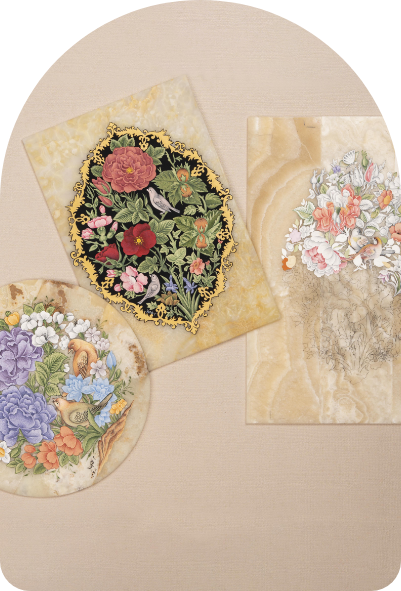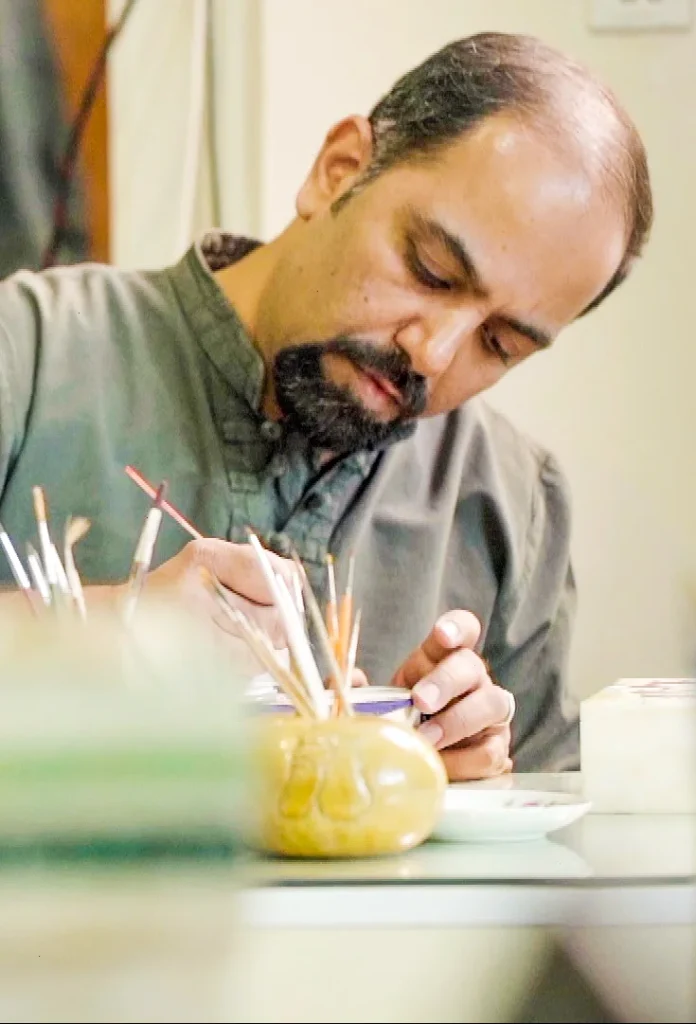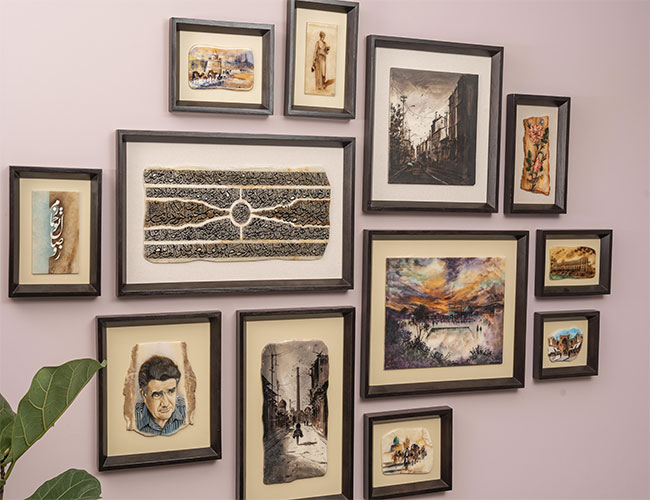
Marmaris Art, Painting on marble
Marmaris is one of the categories of handicrafts, a new and captivating one. Names like Khatamkari, Mina, Ghalamkar, and Firoozeh Koobi are familiar and well-known in the realm of handicrafts. Marmaris, however, is the new and young member of this family, aiming to be a valuable guardian of our ancestors’ legacy. Marmaris is the art of painting on marble.

Marmaris was developed by us in 2008. Using our patented device, we cut marble into 3-millimeter thicknesses to create Marmaris.

Marmaris is crafted from marble stone and painted with the artistic touch of skilled artists. Each piece is not only painted by hand but also showcases the unique veins within the marble stone, ensuring no two artworks are identical.

Marmaris can be designed and produced according to your taste and budget. Just let us know what you envision, and we will design and manufacture it for you.

In our team, over 100 exceptional artists design Marmaris artworks, resulting in Marmaris pieces offered in numerous styles and painting designs.
Marmaris is the art of painting on marble
Marmaris is one of the new branches of handicrafts. Similar to enameling, which is the art of painting and decorating the surfaces of metals like gold and copper, and is seen in various products, Marmaris is the art of miniature painting and calligraphy on marble surfaces. This art is manifested in various products such as tabletop vases, boxes, tissue boxes, marble wall panels, and more.
The idea of creating this new handmade art emerged in the alleys of Naqsh-e Jahan Square in Isfahan, the “cradle of Isfahan handicrafts.” This was a time when various handmade products had become merely decorative items, moving from the shop windows to the showcases of homes, serving no other purpose.
Mehrdad Babaei is the first creator of the new style of painting on marble and the originator of Marmaris. He was born in December 1975 into an artistic and art-loving family. Mehrdad Babaei’s father was also a master in the field of miniature painting (Persian painting), and his older brothers were engaged in watercolor and miniature painting. As a result, he became familiar with art from childhood and started practicing miniature painting with his father from the third grade of elementary school.
An art-loving and artistic individual, Mehrdad had a vision during high school: he was concerned with presenting art, but this time in a new form. He sought something that, in addition to beautifying and conveying the positive feeling inherent in art, would have a different appearance—an appearance and form that could be integrated into people’s lives and used in their daily routines.
In his first step to address this vision, he began painting on Khatam (inlaid work) and camel bone products and boxes, but this was neither sufficient nor satisfying for him. Fate led him to meet certain individuals, and ultimately, he succeeded in creating a new artistic product called Marmaris.
These products were not just designed for shelves and showcases; this time, they were intended for the cultural-artistic shopping baskets of families. Among these products are jewelry boxes, tissue boxes, hanging and tabletop vases in various sizes, pen holders, various types of desk and wall clocks, various paintings and frames, and more.
The story of how I came to create the art of painting on marble is a complex one that can perhaps be summarized in two things: my love for art and my desire to honor the name of Iran.
Without Exaggeration or Slogans When I thought of Iran, certain names automatically came to mind that filled me with pride, made my blood rush, my eyes sparkle, a proud smile form on my lips, and my chin tremble with excitement. Surely, I was and am a patriotic person, but all these feelings did not just stem from patriotism.
By nature, I am an art lover, and whenever and wherever I see art, even the smallest piece, excitement and joy surge within me. When I am so moved by a small piece of art, it is natural to be astonished when thinking of Iran. For me, Iran evokes masterpieces of architecture such as Naqsh-e Jahan Square, the hydraulic structures of Shushtar, Persepolis and the tomb of Cyrus, Persian gardens, Bisotun, Soltaniyeh Dome, Bam Citadel, and more. Iran means stunning arts like carpet weaving, Khatamkari (inlaid work), enameling, pottery, and more.
Iran, for me, is the homeland of invaluable masterpieces; masterpieces that have been passed down from our ancestors, and I have always been proud of being Iranian because of them. But exactly at this point, I also felt an ambiguous and regretful feeling. Regret that everything is related to our ancestors, to the distant past; why is there no trace of today in the name of Iran?
Sometimes, when I walked in Naqsh-e Jahan Square, among the bazaar stalls, I was amazed by the artistic creativity, taste, and wisdom of previous generations. I was astonished by how and from whom they had learned to adorn everything they used daily with various arts and give life to their days of living.
Their tablecloths were colorful block-printed fabrics, full of life and meaning, their cooking vessels were made of copper, beautified by hammering, and their buttermilk and water were served in green and blue glass jugs that someone had painstakingly crafted with the art of glassblowing. The charm of the taste of old Iranians was that this beauty and art were not just for the dining table but permeated their entire lives. I would look at old houses and think about how dreamy and exciting it must have been to live in them; every corner of the houses was full of light and energy, brimming with art and beauty!

At that time, I thought that my delightful and pleasant feelings toward everything from the past, filled with creativity and art, were solely due to the family and culture in which I was raised, and my gentle nature, which stemmed from close contact with various dimensions of art. But now I know that there are many people who think like me, feel about our past as I do, and are as excited as I am about the artistic love and creativity of our ancestors.
From what I understand, it seems that nowadays, my people prefer to spend their leisure time in such peaceful and traditional accommodations and houses. And if, unfortunately, they do not get a room in these houses, they choose luxurious and modern hotel rooms.
It is as if we all have a deep, rarely seen thirst and need for this beauty within us. Perhaps this thirst arose because, unlike our fathers, we did not use enamel plates for serving our rice, copper pots and pans for cooking, blue glass jugs and cups crafted with glassblowing art for serving our drinks; block-printed fabric as tablecloths, clay and pottery vases for our flowers. Perhaps the reason for this need is that even our windows are no longer traditional stained glass; those colorful stained glass windows have turned into soulless double-glazed clear panes!
The issue was that we no longer regarded handmade art and craftsmanship as part of our daily lives, unlike previous generations. We suddenly replaced all that beauty with the soulless mass production of factories. Our greatest reverence for handicrafts became placing a few pieces in a corner of the display cabinet at home. Eventually, even these handicrafts were replaced by modern products from other countries.
As a member of the new generation, I, Mehrdad Babaei, felt the lack of spirit and vitality in our daily lives. I wanted my way of living and my environment to resemble our forefathers’ a bit more and to bring back the art that we had long banished from our lives. At this point, I decided not to just be content with the valuable heritage passed down to us, but to also leave a remarkable legacy and art for future generations. Just as we have inherited and enjoyed the arts of pottery, enameling, inlaid work, copper work, and more, it is only fitting that we too have a valuable heritage for the future. A heritage that both showcases the deep-rooted art of Iranians and incorporates elements of today’s achievements in technology and machinery.
And so, Marmaris was born; when stone succumbed to art, and the dance of the pen on marble’s surface imparted softness to the hard stone.
Marmaris has one foot in today’s technology and a firm root in the art of the past. The body of Marmaris is marble stone, cut with modern knowledge and technology, and its soul is the art of miniature painting and calligraphy, rooted in ancient times.

The journey of Marmaris marble products begins with their extraction from the mines. These magnificent stones are then carefully transported from the mine to the factory.
Upon entering the factory, large blocks of marble, known as “cubes,” are cut with high precision using specialized cutting machines called “block cutters.”
Usually, white marble is the most common choice and has the most fans. However, Marmaris also offers other diverse colors such as green, orange, honey, and pink, which enhance the creativity of Marmaris works.
The cut marble slabs, which are usually between 4 and 10 cm thick, are carefully transported to the Marmaris workshop, where the production and completion of the final product begin.
Once the painting process is complete, the painted products are returned to the main workshop where all works and paintings are reviewed and inspected again. If there are any defects, corrections are made, and the products are sent to the polyester workshop.
One of the most challenging stages in producing decorative and serving marble items is the polyester coating, which requires a lot of skill and experience. The purpose of applying polyester is to make these beautiful artistic products resistant to moisture and to preserve the paintings on the stone. Depending on the texture of the stone, each product is sprayed with polyester 3 to 5 times.
During the spraying of polyester, care must be taken to ensure that the thickness of the polyester does not vary in different parts of the stone and does not run. After each stage of polyester spraying, the product is hand-sanded. The goal of this sanding is to create fine scratches on the previous layer so that the next layer of polyester adheres better.
The more extensive the sanding, the more transparent the final product will be. There are holes and porous spaces in the surface of the marble that are attempted to be filled with putty and glue, but if some of these pores remain open, the trapped air inside these pores is released during the polyester application, causing the polyester to bubble.
All polyester processes are vital to ensure the durability and beauty of Marmaris marble products.
The result of this perseverance has been honors such as being selected five times at the Tehran International Handicrafts Exhibition, winning the Creativity and Innovation section at the Mashhad-al-Reza Handicrafts Festival, being chosen at the first Applied Science Universities Festival in the country, receiving the national mark for artworks from the National Handicrafts Organization, and being awarded the top booth at exhibitions in Italy and Beirut.
The policy of this collection is to add several new products to the production cycle each year. This strategy aligns with the team’s motto of maintaining dynamism and expanding product diversity.
Beyond the pure essence of nature and its precious gift, marble, selecting this product offers several advantages:
Art is a universal language that spreads the spirit of life and humanity and has always played a significant role in promoting peace and countering war. we strive to utilize this intrinsic artistic potential in the best possible way.
برای تغییر این متن بر روی دکمه ویرایش کلیک کنید. لورم ایپسوم متن ساختگی با تولید سادگی نامفهوم از صنعت چاپ و با استفاده از طراحان گرافیک است برای تغییر این متن بر روی دکمه ویرایش کلیک کنید. لورم ایپسوم متن ساختگی با تولید سادگی نامفهوم از صنعت چاپ و با استفاده از طراحان گرافیک است.
برای تغییر این متن بر روی دکمه ویرایش کلیک کنید. لورم ایپسوم متن ساختگی با تولید سادگی نامفهوم از صنعت چاپ و با استفاده از طراحان گرافیک است.
برای تغییر این متن بر روی دکمه ویرایش کلیک کنید. لورم ایپسوم متن ساختگی با تولید سادگی نامفهوم از صنعت چاپ و با استفاده از طراحان گرافیک است.
برای تغییر این متن بر روی دکمه ویرایش کلیک کنید. لورم ایپسوم متن ساختگی با تولید سادگی نامفهوم از صنعت چاپ و با استفاده از طراحان گرافیک است.
برای تغییر این متن بر روی دکمه ویرایش کلیک کنید. لورم ایپسوم متن ساختگی با تولید سادگی نامفهوم از صنعت چاپ و با استفاده از طراحان گرافیک است.
برای تغییر این متن بر روی دکمه ویرایش کلیک کنید. لورم ایپسوم متن ساختگی با تولید سادگی نامفهوم از صنعت چاپ و با استفاده از طراحان گرافیک است.
برای تغییر این متن بر روی دکمه ویرایش کلیک کنید. لورم ایپسوم متن ساختگی با تولید سادگی نامفهوم از صنعت چاپ و با استفاده از طراحان گرافیک است.
لورم ایپسوم متن ساختگی با تولید سادگی نامفهوم از صنعت چاپ و با استفاده از طراحان گرافیک است. لورم ایپسوم متن ساختگی با تولید سادگی نامفهوم از صنعت چاپ و با استفاده از طراحان گرافیک است.
برای تغییر این متن بر روی دکمه ویرایش کلیک کنید.
برای تغییر این متن بر روی دکمه ویرایش کلیک کنید.
برای تغییر این متن بر روی دکمه ویرایش کلیک کنید.
برای تغییر این متن بر روی دکمه ویرایش کلیک کنید.
Marmaris is the name of a new and captivating handicraft. Wood inlay, enamelwork, penmanship, and turquoise inlay are familiar names in the world of handicrafts that we often hear. Marmaris, however, is the new and young member of this family that has come to be a valuable heir to its ancestors. Marmaris is the art of painting on marble.